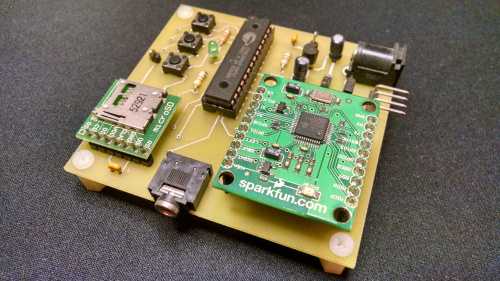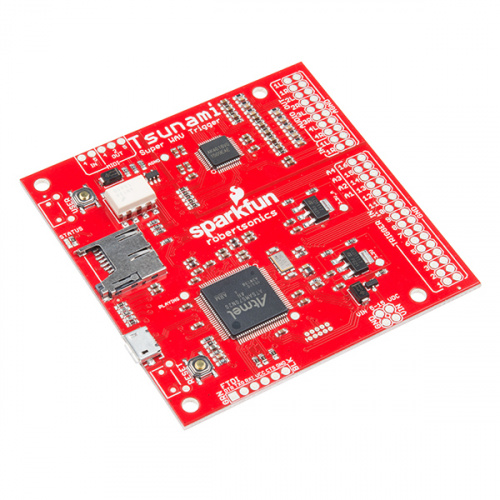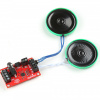We're breaking tradition a little today. New SparkFun products are usually announced on Friday mornings, but because my spot in the blog schedule aligned with the release of one of the biggest products I've worked on, we're jumping the gun and releasing this one a day early!
Meet Tsunami.
Tsunami was developed as a collaboration with Jamie Robertson, who happens to also be the brains behind the MP3 Trigger and WAV Trigger.
The WAV Trigger was the first project board of its kind, offering polyphonic playback of uncompressed WAV files. Tsunami is the super WAV trigger, offering more polyphony, more outputs, seamless file looping, stereo and mono file playback, and MIDI support.
Let's let Jamie introduce himself and explain Tsunami.
Jamie Robertson of Robertsonics
To begin, can you introduce yourself to our readers?
I've spent about half of my professional career working for Walt Disney Imagineering, the design and engineering division of the Walt Disney Company, creating our theme parks, resort properties and cruise ships. I was involved in the opening of EPCOT Center in 1982, and Disneyland Paris in 1992, and designed the on-board audio system used in many of our ride vehicles. I'm currently an Executive R&D Imagineer at our Glendale, CA, campus, doing applied technology research for future parks and attractions.
My time at Disney has been interspersed with consulting for the music tech and audio industry, and I've had the good fortune to work on some seminal products, including Roger Linn's early drum machines, 360 Systems MIDI gear and the New England Digital Synclavier.
How did you first come across SparkFun?
Around 2006 I discovered this cool company making breakout boards that made it so much easier to hand-build prototypes using SMT components. I started buying parts on a regular basis.
What led to you collaborating with us on the MP3 Trigger and WAV Trigger?
I was working on an interactive art exhibit in 2007 and needed an embedded audio player that could perform smooth volume changes. I couldn't find one, so I designed an MP3 player based on the VLSI MP3 Decoder, a Cypress PSoC and a microSD card. The prototype used a couple of BoB from SparkFun. I went to Maker Faire that year and happened to take my working prototype along.
SparkFun was there - I introduced myself to Nate, and he immediately saw value in the idea of a complete, easy-to-use embedded audio player. It was his idea to add trigger inputs (I had only needed serial control). We worked out the specs over the next couple of weeks and thus was born the MP3 Trigger.
The WAV Trigger was my answer to the oft-asked question, "Why can't I play more than one sound at a time?" My original goal was for maybe four high-quality audio streams, but after playing around with the STM32F4 Arm Cortex-m4 processor, I realized I could do much more than that. It ultimately turned into 14 uncompressed, 16-bit, 44.1kHz stereo files that could be triggered with very low latency. With the addition of MIDI support and dynamic voice-stealing, the WAV Trigger has turned into a playable musical instrument.
You often use the words "voices" and "polyphonic." What do they mean?
These terms come from the world of synthesizers and samplers. A "voice" is a construct - either hardware or software - that can play a waveform. The waveform can be generated or recorded. In an analog synth, a voice is an oscillator or waveform generator. For the MP3 Trigger, WAV Trigger and Tsunami, a voice is what's responsible for playing one audio file from the microSD card. "Polyphonic" simply means more than one voice. The MP3 Trigger is monophonic, because it can only play one MP3 stream at a time. The WAV Trigger is polyphonic, because it can independently play up to fourteen 16-bit, 44.1kHz stereo WAV files simultaneously.
To be playable as a musical instrument, voices are assigned dynamically as needed. The WAV Trigger and Tsunami have what's called a voice-stealing algorithm, common in keyboard synths, that gives priority to new requests to play sounds. This means that if you're playing a lot of MIDI notes with long release times and you use up all the available voices, new notes will steal voices from the oldest notes, and you'll likely not even notice.
And now there's a new device, Tsunami. Can you tell us more about that?
Tsunami is my answer to demands such as, "I want more voices, seamless looping and more than two channels of output!" Tsunami has eight audio output channels, which can be treated as either eight individual mono outputs or four stereo outputs. With the move to the new Atmel SAM S70 Arm Cortex-m7, Tsunami provides up to 18 stereo or 32 mono CD quality tracks. With the ability to start multiple tracks to multiple outputs in sync, it may be the first embedded audio player that can play 5.1 and 7.1 surround with a single trigger input. Additional memory also gives Tsunami the ability to do true seamless looping.
The major bullet points for Tsunami are:
- 18 stereo/32 mono 16-bit, 44.1kHz polyphony
- Four stereo/eight mono audio outputs
- Independent volume and pitch bend control for each output
- Seamless looping over WAV files
- Dedicated MIDI IN/OUT port with on-board opto-isolator
- Firmware updates directly from microSD card
- On-board reset button that allows changing card without cycling power
- MIDI Note output assignment allows for splitting keyboard across multiple outputs and more....
What is the coolest, most interesting, or most unusual application of these boards that you've seen?
I've been impressed by the range of projects folks have built using these audio players: new expressive musical instruments, pinball machine retrofits, model railroads, interactive museum exhibits... here are a couple that stand out:
And of course the guy who just recently tricked out a synth bike:
So when and where will Tsunami be ready for the public?
Right here, right now!











It's should also be mentioned that Mr. Robertson also provides very good, very fast support for his products in the Sparkfun forum.